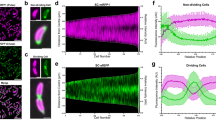Summary
In several cryptomonad genera the surface periplast component (SPC) is composed of discrete crystalline plates surrounded by structurally distinct borders. Freeze-etch images enable detailed investigation of surface microarchitecture in these cryptomonads, and reveal that the plates consist of precisely aligned arrays of minute subunits. The plate borders are composed of similar subunits which display marked variations in alignment. Differences in the arrangement of subunits within the plates and borders appear closely linked to the organization of the underlying plasma membrane (PM) and inner periplast component (IPC). Development of the crystalline surface plates occurs within specialized anamorphic zones located along the mid-ventral line and around the vestibular margins of cells. Examination of variations in surface microarchitecture within anamorphic zones suggests that the crystalline plates form directly on the cell surface. Development of the surface plates results from the accumulation and self-assembly of subunits, while orderly addition of subunits to plate edges facilitates subsequent growth and enlargement. The close structural relationship between the SPC, PM, and IPC in these cryptomonads suggests that self-assembly of the surface plates may be mediated by developmental changes in the underlying PM and IPC.
Similar content being viewed by others
References
Brett SJ, Wetherbee R (1986) A comparative study of periplast structure inCryptomonas cryophila andC. ovata (Cryptophyceae). Protoplasma 131: 23–31
— — (1996a) Periplast development in Cryptophyceae I. Changes in periplast arrangement throughout the cell cycle. Protoplasma 192: 28–39
— — (1996b) Periplast development in Cryptophyceae II. Develop ment of the inner periplast component inRhinomonas pauca, Proteomonas sulcata [haplomorph],Rhodomonas baltica, andCryptomonas ovata. Protoplasma 192: 40–48
Cohn SA, Spurck TP, Pickett-Heaps JD, Edgar LA (1989) Perizonium and initial valve formation in the diatomNavicula cuspidata (Bacillariophyceae). J Phycol 25: 15–26
Faust MA (1974) Structure of the periplast ofCryptomonas ovata var.palustris. J Phycol 10: 121–124
Gantt E (1971) Micromorphology of the periplast ofChroomonas sp. (Cryptophyceae). J Phycol 7: 177–184
Guillard RRL, Ryther IH (1962) Studies on marine planktonic diatoms. I.Cyclotella nana Hustedt, andDetonula confervacea (Cleve) Gran. Can I Microbiol 8: 229–239
Hausmann K, Walz B (1979) Periplaststruktur und Organisation der Plasmamembran vonRhodomonas spec. (Cryptophyceae). Protoplasma 101: 349–354
Hill DRA (1991)Chroomonas and other blue-green cryptomonads. J Phycol 27: 133–145
—, Wetherbee R (1986)Proteomonas sulcata gen. et sp. nov. (Cryptophyceae), a cryptomonad with two morphologically distinct and alternating forms. Phycologia 25: 521–543
— — (1988) The structure and taxonomy ofRhinomonas pauca gen. et sp. nov. (Cryptophyceae). Phycologia 27: 355–365
— — (1989) A reappraisal of the genusRhodomonas (Cryptophyceae). Phycologia 28: 143–158
Kugrens P, Lee RE (1987) An ultrastructural survey of cryptomonad periplasts using quick-freezing freeze fracture techniques. I Phycol 23: 365–376
Messner P, Sletyr UB (1992) Crystalline bacterial cell-surface layers. Adv Microb Physiol 33: 213–275
Roberts K, Shaw JI, Hills GJ (1981) High-resolution electron microscopy of glycoproteins: the crystalline cell wall ofLobomonas. J Cell Sci 51: 295–321
Santore UJ (1977) Scanning electron microscopy and comparative micromorphology of the periplast ofHemiselmis rufescens, Chroomonas sp.,Chroomonas salina and members of the genusCryptomonas (Cryptophyceae). Br Phycol J 12: 255–270
— (1982) Comparative ultrastructure of two members of the Cryptophyceae assigned to the genusChroomonas — with comments on their taxonomy. Arch Protistenk 125: 5–29
— (1987) A cytological survey of the genusChroomonas — with comments on the taxonomy of this natural group of the Cryptophyceae. Arch Protistenk 134: 83–114
Shaw PJ, Hills GJ (1982) Three-dimensional structure of a cell wall glycoprotein. J Mol Biol 162: 459–471
Sletyr UB, Messner P (1983) Crystalline surface layers on bacteria. Annu Rev Microbiol 37: 311–339
Author information
Authors and Affiliations
Rights and permissions
About this article
Cite this article
Brett, S.J., Wetherbee, R. Periplast development in Cryptophyceae III. Development of crystalline surface plates inFalcomonas daucoides, Proteomonas sulcata [haplomorph], andKomma caudata . Protoplasma 192, 49–56 (1996). https://doi.org/10.1007/BF01273244
Received:
Accepted:
Issue Date:
DOI: https://doi.org/10.1007/BF01273244




